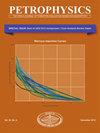Joint Inversion of Saturation and Q in Low-Permeability Sandstones Using v Spontaneous Potential and Resistivity Logs
IF 0.7
4区 工程技术
Q3 ENGINEERING, PETROLEUM
引用次数: 0
Abstract
Hydrocarbon saturation is an important formation parameter and the basis for quantitative reservoir evaluation. However, the saturation models of shaly sandstones contain more parameters than clean sandstones; therefore, determining these parameters for shaly sandstone is difficult. In this study, based on the response of spontaneous potential (SP) logging, the membrane potential equations of shaly sandstone in water-saturated and oil-water states were derived, and an analytical equation of the anomaly amplitude of the SP in shaly sandstone was obtained. On this basis, the influencing factors of the SP anomaly were analyzed. Furthermore, a joint inversion of SP and resistivity was established to calculate oil saturation and cation exchange capacity per unit pore volume (Qv). The SP log was interpreted using the proposed analytical model, and the resistivity log was processed using the Waxman-Smits model. The particle swarm optimization method was used to resolve the objective function. Finally, the method was applied to the Chang 8 Reservoir in Yanchang, on the western edge of the Ordos Basin, China. The resistivity and SP log curves synthesized using the inverse parameters agree with the field logs. The inversion of the saturation and Qv is consistent with core data and oil testing, indicating that the joint inversion method is stable, reliable, and accurate.利用v自发电位和电阻率测井联合反演低渗透砂岩饱和度和Q值
含油饱和度是重要的地层参数,是储层定量评价的依据。然而,泥质砂岩的饱和模型比洁净砂岩包含更多的参数;因此,确定泥质砂岩的这些参数是困难的。基于自然电位测井响应,推导了页岩砂岩在水饱和和油水状态下的膜电位方程,得到了页岩砂岩自然电位异常幅值的解析方程。在此基础上,分析了SP异常的影响因素。建立SP和电阻率联合反演方法,计算含油饱和度和单位孔隙体积阳离子交换容量(Qv)。利用提出的解析模型解释SP测井,利用Waxman-Smits模型处理电阻率测井。采用粒子群优化方法求解目标函数。最后,将该方法应用于鄂尔多斯盆地西缘延长长8储层。利用反演参数合成的电阻率和SP测井曲线与现场测井曲线吻合较好。饱和度和Qv反演结果与岩心资料和试油结果一致,表明联合反演方法稳定、可靠、准确。
本文章由计算机程序翻译,如有差异,请以英文原文为准。
求助全文
约1分钟内获得全文
求助全文
来源期刊

Petrophysics
地学-地球化学与地球物理
CiteScore
1.80
自引率
11.10%
发文量
40
审稿时长
>12 weeks
期刊介绍:
Petrophysics contains original contributions on theoretical and applied aspects of formation evaluation, including both open hole and cased hole well logging, core analysis and formation testing.
 求助内容:
求助内容: 应助结果提醒方式:
应助结果提醒方式:


